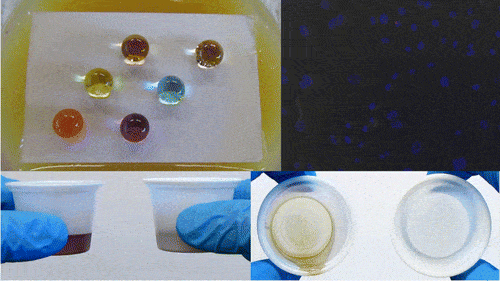
No matter how much you try, there will always be some drops of ketchup stuck to the bottom and walls of the bottle. Same with just about any sticky, gooey liquids like honey or syrup. Not content to live any longer with such nuisance, a team of researchers developed a safe coating derived from natural materials that can effortlessly slide liquids off. Virtually any liquid can be empty from a container layered in this coating.
An elegant solution to a sticky problem
What the Colorado State University researchers essentially did was to develop a superhydrophobic coating — a nanoscopic surface layer that repels water. Examples of such coatings abound in nature where some plants, such as the Lotus leaf, and some insect wings employ it. Artificial superhydrophobic coatings have been made using materials like precipitated calcium carbonate, silica nanocoating or manganese oxide polystyrene.
[panel style=”panel-success” title=”Why some things are sticky” footer=””]Stickiness depends on the interface of two materials. Honey in itself, for instance, isn’t sticky. It might be when it touches your hand, but not on teflon.
There are several reasons why objects can be sticky, or display adhesive properties. One reason is that certain forces, called Van Der Walls forces, occur between the object and your finger. The molecules are attracted to each other, so it takes force to separate the two once they have come in contact.
Another reason can be more mechanical in nature. For example, if an object’s surface is soft and deformable, when pressed against a rough object, it will deform and ooze into cracks and crevices. Now, to separate the two objects requires that either (1) the soft material get pulled out of cracks and crevices, or (2) the soft material has to get torn apart.
A third mechanism can be the formation of new chemical bonds between the adhesive and the substrate. Such adhesives tend to be very powerful, and the adhesion is harder to reverse. Many adhesives rely on more than one mechanism for their properties.
[/panel]
What’s different in this case is that the coating is 100 percent safe because it was made from carnauba wax and beeswax, two natural FDA-approve edible materials. Previously, the FDA banned three perfluorinated compounds (PFCs) which were used in pizza packaging to keep the food from greasing because they were deemed unsafe.
The researchers tested the superhydrophobic surface with coke, pancake syrup, Lipton tea, Gatorade, ketchup, and water. Each liquid beaded into a sphere which could be rolled off by gravity alone, leaving no trace behind. The same coating was then tested in a real life situation by layering it inside polystyrene cups. The cups were filled with chocolate syrup or honey and again left no trace after the contents were emptied.
The coating breaks when exposed to a harsh or abrassive environment, though, so there’s some room for improvement. Who am I kidding, it looks almost perfect already. Where do I sign up?
Reference: Wei Wang et al. “Superhydrophobic Coatings with Edible Materials.” ACS Appl. Mater. Interfaces 8 (29): 18664–18668. Published: 12-July-2016. DOI: 10.1021/acsami.6b06958
Was this helpful?



